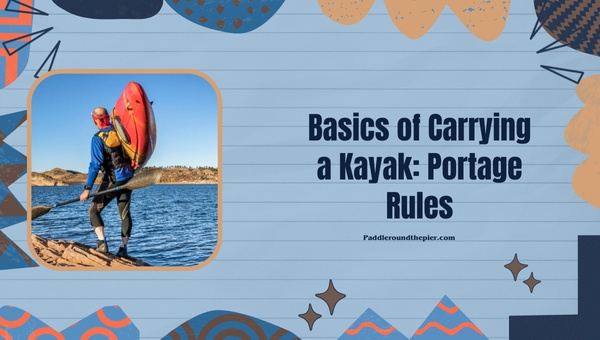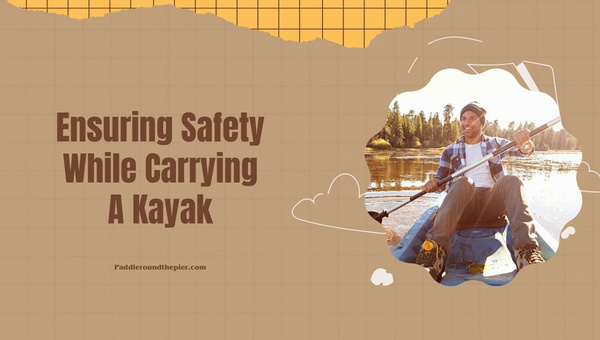Carrying a Kayak: Portage Rules for Adventure Seekers
As a passionate kayaker, I've traveled across vast bodies of water, relishing the solitude and tranquility that only kayaking can provide. But the journey from one waterway to another comes with its set of challenges. Carrying a kayak over a stretch of land, also known as portage, is one such challenge. The portage rules for ensuring the kayak's safety and protecting yourself from potential injuries are topics that aren't addressed as often as they should be.
As an experienced adventurer who has equally spent time brooding over maps as well on the waters, paddling my kayak, I believe that mastering these rules can add another feather to your cap. Not just next time you encounter trickier terrains or longer stretches between two waterways, but each time, one moment rolls over to the next during your excursion.
What You'll Discover Here:
- Unraveling the basics and importance of Kayak Portage
- Essential gear for efficient kayak transport
- Techniques to handle challenging portages - both solo and team
- Precautions for ensuring personal safety and safeguarding your prized possession
- Tips to avoid injuries during canoe portage
Basics of Carrying a Kayak: Portage Rules
Navigating backcountry waters often involves periods where you have to portage your kayak. Understanding the basics of carrying a kayak is crucial for such circumstances. Let's dive into the essentials— from understanding kayak portage itself to all the preparation involved.

Understanding Kayak Portage
Kayak portage simply refers to carrying a kayak overland to bypass an obstacle or connect different bodies of water. It's compelling for kayakers for several reasons:
- Allows you to experience various types of waterways in one trip
- Helps bypass unsuitable or dangerous situations like rapids and low rivers
- Offers access to remote and unexplored areas
- Protects the environment by avoiding paddling in shallow areas, which can damage both your kayak and aquatic plant life
Grasping these key points is fundamental whenever we're dealing with canoe portage, primarily referred to as 'Carrying a Kayak: Portage Rules'. Examining this clearly reveals why mastering kayak handling principles can spell out the difference between an enjoyable paddle journey and one fraught with difficulties.
Essentials for Kayak Portage
Preparation is key in ensuring smooth and efficient kayak transport during a portage. Here are some portaging essentials:
- Physical Fitness & Stamina: Carrying a loaded kayak across uneven terrain may demand stamina, particularly on longer trails.
- High-Quality Gear: Invest in proper equipment like sturdy footwear, comfortable apparel, dry bags, etc., that will endure rough terrains.
- Effective Padding Equipment: Having durable yet comfortable shoulder pads could be vital during long-distance hauling.
- Protective Accessories: Equip yourself with bug spray, sunblock lotion, and hydration essentials depending on the weather conditions!
The above points emphasize that even highly skilled kayakers require good preparation when undertaking 'Carrying a Kayak: Portage Rules.' The physical demands of kayak transport can be strenuous. However, with the right gear and careful planning, any obstacle becomes a mere interlude in your wonderful paddle journey.
While this guide keeps the basics at its center, we'll delve into more specific carrying techniques and safety precautions in forthcoming discussions!
Also Read: Paddle Board Size Guide: How To Pick The Perfect One For You
Techniques to Carry a Kayak: Portage Rules
Whether you're planning a day-long outing or gearing up for a multi-day adventure, mastering the art of carrying a kayak is vital. From solo moves to team techniques, let me take you through the nitty-gritty of portage rules that'll certainly make your next excursion much more manageable.
Solo Carrying Techniques
When it comes to carrying a kayak alone, it's all about learning how to maneuver effectively and efficiently. I've gathered some methods that can help simplify solo kayak transportation during portages:
- Over-the-Shoulder Technique: Rest the cockpit rim on your shoulder while balancing the kayak’s weight across your back. Make sure to grip either side of the cockpit as you walk.
- Chest Carry: Extend one arm into the cockpit and lift from there. Letting the boat rest against your chest as if carrying an oversized baby makes for comfortable transport.
- Using Portage Straps or Yokes: These accessories attach directly to your kayak, allowing you a hands-free carry, much like traditional canoe portage.
Remember, it's not just about muscle power but also strategy! You need balance and technique when handling heavy weights over unpredicted terrains.
Team Carrying Techniques
Moving along from solo techniques, sometimes having an extra set of hands comes in handy when transporting larger kayaks during long portages. That’s where team-carrying techniques step in:
- The Parallel Position: Stand on opposite sides of the kayak, facing each other with both ends lifted simultaneously while maintaining an even balance throughout transit.
- Perpendicular Position (Tandem Lift): One person stands at each end of the boat, lifting it off from ground level, creating its momentarily floating illusion.
For both these methods, regular communication is key! Not only does this avoid any unnecessary strain or mishandling, but it efficiently optimizes teamwork.
Regardless of which technique you opt for, 'Carrying a Kayak: Portage Rules' always involves focusing on your comfort and assessing the distance that needs to be covered. Don't rush it; take breaks if needed, and remember, it's about enjoying the journey as much as reaching the destination.
Also Read: Winter Kayaking: Your Ultimate Guide To Master the Chill
Ensuring Safety While Carrying A Kayak
Keeping yourself and your kayak safe during portage is non-negotiable. This section is here to guide you through the vital precautions to take when carrying a kayak and how to avoid common injuries that might occur on portages.

Precautions to Take
When it comes to carrying a kayak, certain safety precautions can't be overlooked. These measures are not just for your personal safety, but they are also critical for the protection of the equipment involved, especially the kayak itself.
- Use Proper Equipment: Invest in a good quality kayak carrier; they make transportation easier and safer. Always check if all gear needed for portage, like ropes, straps, and pads, are in good condition before setting out.
- Check Your Route: Scouting the route beforehand allows you to identify obstacles and rough terrain that could lead to slips or falls during transport. Avoid these areas as much as possible.
- Wear Proper Footwear: It’s easy to overlook, but closed-toe shoes with good traction significantly reduce potential accidents by offering stability on different terrains.
- Personal Protective Equipment (PPE): If possible, wearing helmets or hard hats can save you from head injuries from any accidental falls or hits while portaging.
Avoiding Injuries
Injuries during kayak portage are often due to improper handling techniques.
- Gain Knowledge: Improper lifting techniques cause most injuries during portage - ensure proper research or professional training on how best to lift and carry your specific model of kayak.
- Use your knees instead of your back: When lifting any substantial weight (like a fully loaded Kayak!), bend at the knees instead of the waist, which otherwise could harm your back severely.
- Quick rest Breaks: Frequent rests between long distances save you from muscle fatigue, which can lead to significant damage in the long run!
Good preventive techniques coupled with the necessary safety gear will make carrying a kayak during portage a pleasant experience rather than a daunting task.
By ensuring you follow these precautions and techniques, you're not just making your kayak transport safer but also preventing potential damage to your valuable equipment. Therefore, careful planning and an eye for safety are key for successful and injury-free kayak portage!
FAQs
What is the proper technique to carry a kayak?
The correct carrying technique depends on whether you're solo or in a team. For solo, center your body under the kayak's weight using shoulder straps for support. For team-carrying, distribute the weight evenly and communicate constantly to ensure synchrony.
How do I prevent injuries while carrying a kayak during a portage?
To avoid injuries, always use appropriate lifting techniques – bend at your knees, not your back. Also, using portage gear like straps or carts can reduce strain. Taking regular breaks during long portages limits exhaustion and reduces the risk of injury.
Are there any specific rules or laws about carrying a kayak on public land during portages?
Rules may vary depending on local regulations. Most public lands require non-motorized transportation methods like manual carts during portages, and respect for surrounding wildlife and the environment is often emphasized. Always check with local authorities for specific rules before your outing.
Conclusion
The essence of carrying a kayak comes down to understanding portage rules and employing effective techniques. Whether solo or in a team, it's vital to take note of safety precautions and the steps needed to avoid injuries during this process.
Making use of the right gear and knowing about proper kayak handling can save not only time but also prevent potential damage to your equipment.
Key Takeaway Points
- Understand what kayak portage is and its importance
- Equipment preparation for carrying a kayak is necessary
- Learn different techniques for solo or team kayaking
- Safety should be prioritized when handling a kayak.
